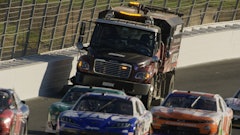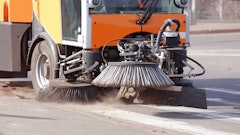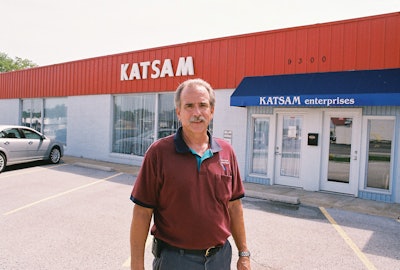
How much does your sweeping company need to generate per route to be profitable?
Katsam’s Jim Larko and Sam Nicholas would say if you don’t know the answer to that question your company is already in trouble.
“I used to do that by the seat of my pants but we haven’t done it that way for a long time,” says Larko, president of the St. Louis company and vice president of the North American Power Sweeping Association. “There are a lot of ways people estimate what their cost of doing business is, and we take it to the extreme, but however you do it you need to know your cost of doing business.”
Especially in an economy like this one, outside of paving contractors, the industry segment hit hardest by the current economy is probably contract sweepers, especially those that specialize in parking lot sweeping. Over the last few years more and more sweeping contractors have seen their business decline, mainly in frequency of sweeps per property and sweeping service fees.
Katsam LLC in St. Louis, MO, is no exception, and over the last few years the contractor has made a variety of efforts to control costs. “We looked at everything and we tracked everything,” says Nicholas, operations manager.
One example is tires. He says when they first started tracking, each tire would be given a number when it was purchased, then that number enabled them to track that tire throughout its life. The miles of use and cost per mile for the tire was applied to each property swept and factored into each sweeper’s route, as were trash bag costs, all vehicle maintenance and service, insurance, operator costs (including benefits and overtime), as well as administrative overhead. All these costs (and more) are charged back to each property, which gives Katsam a pretty good handle on what it costs to sweep a particular property. Perhaps even most important, it also gives them a basis from which to bid.
“It probably was overkill and we’ve probably over thought it but we know what our costs are on a daily basis for each route,” Larko says. “We know what our base number is for a route to be profitable.”
In 2009 Katsam was sweeping more than 350 properties at frequencies ranging from once a quarter to seven days a week, and over the last few years that number has fluctuated between 330 and 350. Today Katsam’s 30 employees generate 65% of sales from parking lot and garage sweeping, 25% from power washing, and 10% from day porter work. In January 2010, coming off a good 2009, Katsam moved into a new building renting with an option to buy. “That year capped 13 years of growth in parking lot sweeping but the last two years have been negative,” Larko says.
Larko and Nicholas credit their long-time efforts at knowing their costs and their efforts to control their costs for helping them survive since then, because the market has changed and Katsam’s approach had to change along with it.
“I’ve always been a problem solver. I solve problems for my customers when they’ve presented me with a challenge -- that’s how I got into power washing and sweeping in the first place,” Larko says. “But in the last couple of years there’s been a big change because now the market isn’t interested in us solving their problems -- they just want everything done more cheaply, and that conflicts with our approach.
“We can do it cheaper but we can’t provide the level of service we want to provide -- and that they want us to provide -- for that amount of money. Our challenge over the past couple of years has been communicating that to our customers.”
But that’s an external challenge. Internally Katsam has been fighting – and winning -- the costs battle by examining hiring and training practices, payroll, routing, and even equipment, which the contractor has put on hold.
Making Routes More Profitable
Larko and Nicholas say that a cost-saving option available to all contract sweepers is an examination of all their sweeping routes. Katsam has established a base revenue they need to generate from each route and the contractor is constantly vigilant to make sure routes reach at least that target level. Properties can be shifted from one route to another as accounts are added or removed, and driver times are monitored to make sure route meet the minimum level. Through the same process routes are monitored so they can be as profitable as possible with some of Katsam’s routes generating considerably more in revenue.
Larko and Nicholas say that organizing sweeping routes is a constant challenge, a challenge made more difficult by changing tenants on properties and local noise ordinances (Katsam sweeps throughout 114 municipalities “and all of them have different noise ordinances”).
One hypothetical example: Assume a contractor sweeps a strip mall property with tenants that close by 9:00 p.m., in other words there’s no bar on the property so Katsam can sweep it at 11:00 p.m. “Then a bar opens on the property and suddenly you can’t sweep it until two or three in the morning because the parking lot is full or at least busy. Now you have to decide where to move that property on your routes to get it done, and you have to figure out not only which route to move it to but does it replace a property on the other route or are you adding a sweep to that route? What does that do to the other operator’s time? And where is that other driver at the time that bar property now must be swept? Where does he have to come from to sweep that property at 2:00 or 3:00 in the morning? How does it affect the rest of the route? Does a property come out of that other route to fit the new property in? And how is the route the bar property is taken from affected with one less sweep?
Among the greatest savings Katsam has found have come through improving route density. “We try to group more properties closer together,” Nicholas says. “Less travel time means more time on the property.”
Larko says improving route density can be tricky to manage and can encourage some sweeping contractors to bid a property for less than their “normal fee” if the property is within a route’s geographic area.
“But we don’t really cut prices bidding a job even if that job fills a gap in our route or even if it’s near by a route,” Larko says. “Say you bid that job at a lower rate to make sure you get it and because it fits well in that route. But what happens if you lose one of the anchor accounts on that route, say a big shopping center? Then you have a contract to sweep a property at a lower rate and smaller profit margin than you would typically do -- and maybe you are sweeping that property for less than you need and want. So all of a sudden you’ve got an unprofitable contract to sweep a job.
“So we try to keep bid work consistent,” he says. “We’ll go a little out of our way for some of our bigger customers, maybe to do a new property because they need it. But we try to maintain route density and if we add something out of our way that’s just something we do to help our customers.”
The Value of Training
Katsam discovered another area of cost savings when it looked into its hiring and training processes. A study the company had done estimated it cost $8000 to train an employee to get to a minimum level of proficiency. Results assumed a driver isn’t fully productive until at least 30 working days on the job: he’s slower to each parking lot as he learns the routes, he’s slower sweeping each lot as he learns what’s involved, he wears out tires more quickly (increasing tire costs), and there’s additional wear and tear on equipment until he learns to handle it better.
Once Katsam came to that realization they established a formal training program that requires a new operator to work a minimum of 40 hours of training before he’s cut loose on his own. “It’s a documented training program where they work through specific items each night, some of which are repeated from night to night. It’s not just one time,” Nicholas says. “It’s repetitive.”
He says the new driver spends at least his first night outside the sweeper, not behind the wheel. “He’ll blow sidewalks and do work outside the vehicle and watch the driver,” Nicholas says. “The new hire doesn’t know his way around and he doesn’t know the properties, so it makes sense to have someone else do the driving.” He adds the experienced driver follows a checklist of what the driver needs to do on each lot and the new hire learns from that.
Then once a new driver is on his own, Katsam’s night supervisor drives out and checks on drivers and checks the parking lots they’ve swept. “You check on them while they’re learning and new to the job otherwise they develop bad habits,” Nicholas says. “It’s much easier to teach them to do it right from the beginning and check on them to make sure they do.”
Nicholas says Katsam’s turnover rate has plummeted since the training program was implemented. “We’re more selective to get the right candidate, and we either train them or make the decision early that they are not going to work out,” he says. “It does cost us a little more up front in overtime while we’re trying to find the right person, but once we find the right person it’s a longer-term cost savings.”
And once Katsam identifies a good prospect they start him (or her) at $9 an hour with potential raises up to 50 cents and hour at 30, 60 and 180 days. Benefits include a four-day workweek, health insurance (at six months), an employee assistance program, seven paid holidays, 401(k) plan with a company match, and two weeks paid vacation after one year.
“Plus they get to work in a safe truck,” Larko says. “I don’t allow a driver to take a truck that’s not safe out on the road and our maintenance department has standards that will not allow an unsafe truck on the road."
Tracking – and Reducing – OT
Larko says another area that caused concern was operator overtime. Most contract sweepers accept overtime as a natural part of the business, but there’s a difference Larko says between justified and unjustified OT.
“We had reached the point where overtime was out of control and we hadn’t added anything new,” Larko says. “It was just a level people were getting comfortable with, both our drivers and us.”
But as the economy got tougher and clients were cutting back, Katsam looked to see what they could do to trim its overtime pay.
“We had a handle on all our other costs, but we were driven to figure out what was going on with overtime. We wanted to know what generated the OT each week,” Nicholas says. “If we have special jobs, fine. If people are out sick and another driver has to work longer to cover him, okay. But if we had 30 hours of OT that we can’t account for then we have to fix that.”
Katsam’s first step was to find a way to monitor exactly what was happening each night. The traditional time clock employees punched didn’t provide the specifics they needed, so they turned to a GPS system called Eagle Eye. Among the capabilities of the system are:
* If the driver is in the truck and the truck isn’t moving it considers them on break and they get no credit for that time or toward overtime
*It documents and can display on a computer screen driver routes, sweeping patterns, and speeds on the route and while sweeping
Nicholas and Larko wanted the GPS to tie directly into their payroll system, and once the two were integrated, they could generate payroll directly from the GPS information is when some real savings came to light.
To verify the new GPS information “We were tracking what we were doing on time cards and then we also tracked it on the computer using Eagle Eye,” Nicholas says. “We put the information into spread sheets which we taped to the windows between our offices so we could monitor what was going on, this took about six weeks.”
Among what they learned was that employees were coming in to the office, punching in, and then standing around having a cigarette, going to the bathroom, talking with other drivers, changing into their uniform, and doing the pre-trip check of the truck. Similar types of things were happening at the end of the day.
“It was taking them 45 minutes to get out onto the route and the same thing coming back in,” Nicholas says. “That’s a lot of time wasted that ends up as overtime by the end of the day.”
As a result Katsam now allows 15 minutes pre trip in the yard and 20 minutes at the end of the shift to clean the truck and do paperwork. “It shouldn’t take longer than that and we’ve saved time on pre- and post-trip checks on the truck,” Nicholas says. “It forces them to get out and do their work.”
“We were paying some guys 13-14 hours a day four days a week and we took it down to 10-10 ½ hours a day with anything over 40 hours per week being overtime,” he says. “We have taken at least 20 hours of OT out of payroll each week, which is 40 hours every pay period,” Nicholas says. “At $15 per hour we’ve saved at least $600 of payroll a pay period, not including taxes. If we save $600 - $900 per pay period times 26 pay periods it adds up to a lot of money.”
He says it also helps Katsam evaluate its manpower. “If we’re averaging 20 hours of OT every pay period that’s half a man on the payroll,” he says. “If that keeps up then we have to consider is it worth our while to bring in another person?”
As a result of all its cost controls Katsam has been able to weather the last couple of years without making significant cuts in employees or benefits. In fact Larko says the only real cuts the company made were done through attrition.
4 Days x 10 hours
In a plan that Jim Larko instituted in Katsam’s early days, each sweeper operator works four nights a week, 10 hours a day. Larko says their system is set up so that two drivers share a route and a vehicle, and the four-day-a-week schedule enables them to overlap and work together one day.
“In a perfect world Operator A and Operator B share one night a week in the truck where they do all the extra stuff on all the properties on that route -- dumpster enclosures, stairwells, islands etc. -- whatever is more difficult and time consuming. Doing those things on that one night can make the sweeps on the other nights go more smoothly, more easily and more quickly.
“In theory it should enable the two operators to develop a relationship and coordinate, and talk about the route and the job and each property, about how they each approach things on the job,” he says. “It was intended to give them an opportunity to exchange ideas, talk about what each should do. It was intended to essentially help them develop into a team and work as a team. That’s one of the goals of that idea and the nut we’re trying to crack now.”
Another advantage of the team drivers is that on those nights when there are two drivers in a truck Katsam has an extra operator already at work that night. “So in case someone can’t make it in we don’t have to hustle and track someone down to get them. We already have someone there who can jump in a truck and get that route started with little delay,” Larko says.
Through attrition, however, this driver overlap system is on hiatus and the company now rotates on-call operators.
From Lawn Maintenance to Parking Lot Sweeping: Katsam LLC
Katsam President Jim Larko says today’s sweeping business is not the business he got involved in when he added sweeping to a lawn maintenance business in the 1990s, and it’s not the business he recommitted to in 1999.
Larko started his own business in March 1986 cutting grass part time. Within six months he had purchased a competing lawn service company, tripling his size, and added full-service lawn care including chemical applications. After one year part time he quit his job and became a fulltime lawn service pro.
The beginning of his transformation into a sweeping company occurred a couple of years later when one customer asked him to pressure wash the property. “So I bought the equipment and started pressure washing at shopping centers, and it took off from there,” Larko says, and he added day porters soon after.
But he says the lawn maintenance industry began to undergo significant changes in the early 1990s so he sold off the lawn service part of the company, kept the pressure washing and day porter parts of the business, and in late 1996 he began to transform Katsam into the company it is today.
“Late in 1996 two of my best customers approached me independently and said ‘you do such good work have you ever thought of going into parking lot sweeping?’ I listen to my customers very well and heard what they were saying,” he says. “They were saying they wanted someone new in the market that would do something different. They obviously couldn’t get what they wanted from the providers at the time. “
So Larko did his due diligence and put the numbers together and went back to the two customers. “I told them ‘this is what I need to get from you to make the move into parking lot sweeping,’” he says. “They agreed to provide that as far as number of sweeps a week and dollars so I went out and bought a sweeper and in December 1996 I started sweeping eight properties, seven nights a week.”
That was the real start of today’s Katsam LLC, but it wasn’t the turning point.
“The real turning point for our sweeping business came in 1999, when one of our trucks ended upside down and totaled on Highway 70,” he says. “The seriousness of the accident made me question why I was in parking lot sweeping. I reviewed the financials of the sweeping operation to see if we were making money since I saw the end of my whole business on the highway -- and the answer was ‘Yes , it is making money so let’s grow it.”
It was at that point that Larko started aggressively pursuing and signing accounts. By 2001 he had three sweepers running every day (with a backup sweeper in the yard) servicing more than 50 accounts, most of which were seven-day-a-week sweeps.
“We were aggressive and it was growing and we continued adding on every year,” Larko says. “From 2001-2006 we averaged adding a truck a year. In 2006 we were running eight trucks every day and on weekends we ran two shifts with two or three trucks out during the day so as not to interfere with the night shift.”
No More Donuts in the Parking Lot
Installation and monitoring of the GPS system has helped Katsam in a number of ways, some involving cost control -- and some just plain control.
- Nicholas monitors the GPS daily, and by keeping close tabs he can see if there’s something that needs further investigation. “I know what to look for and if something looks out of whack then I dig a little deeper to figure out why,” Nicholas says. “For example, if I see 140 minutes of nonproductive time on a route that raises a red flag.” He says that has happened several times but there have been good reasons for it – usually. “In a case like that it’s usually an equipment breakdown or something like that. It doesn’t necessarily mean they just sat there in the cab but it makes me look to see what was going on,” he says.
- Helps Katsam control fuel costs because it monitors engine hours (primarily for maintenance purposes). “But if we see for example that the auxiliary engine ran for nine hours...well, they’re not sweeping the parking lot for nine hours. Turn the darn thing off!”
- Drives preventive maintenance by tracking and tallying hours and miles that dictate when it’s time for certain maintenance.
- Used as a training tool. Because the GPS tracks the sweeper’s route and speed it can be used to show a driver how to change his sweeping pattern (or prove to him Nicholas and Larko can tell when he’s doing donuts in the parking lot).
Tires and Trash Bags
Larko says the current cutback in demand for sweeping is compounded by the rising expenses the sweeping companies can’t pass on to customers. “Costs have gone up tremendously—fuel, replacement parts, trash bags—and we know our costs at one moment and we bid work based on those costs,” Larko says. “But costs keep going up and we can’t pass those increases along because we have a contract to sweep for X dollars -- and few properties are allowing us to add a surcharge even if we can document it.”
Examples of cost increases Larko cites are trash bags and tires. He says they used to buy trash bags a pallet at a time for 6-7 cents per bag; today Katsam buys only enough for six weeks and is paying 11 cents per bag. And when you’re using 4000 bags a year that adds up.
Tires, he says, are a huge expense item for all sweepers, but it’s an expense that can be controlled. “Rookie drivers will get 6000 miles on a set of front tires where a team who knows what they’re doing can get 18000 miles out of a set. If I can jump from 6000 to 12000 miles per tire we’ve really cut expenses,” he says. “If we can get 14,000 miles out of a set of tires we’re doing great.”



![Pavement Awards 2025[main]](https://img.forconstructionpros.com/files/base/acbm/fcp/image/2024/05/PavementAwards_2025_main_.665883e4276e8.png?auto=format%2Ccompress&bg=fff&fill-color=fff&fit=fill&h=100&q=70&w=100)
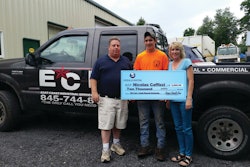
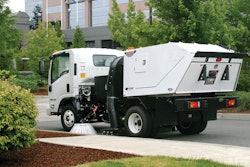
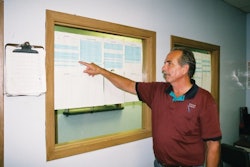




![Pavement Awards 2025[main]](https://img.forconstructionpros.com/files/base/acbm/fcp/image/2024/05/PavementAwards_2025_main_.665883e4276e8.png?ar=16%3A9&auto=format%2Ccompress&bg=fff&fill-color=fff&fit=fill&h=135&q=70&w=240)



